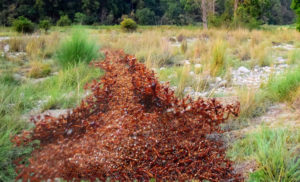Primates were not social animals when they evolved from the primitive insectivore ancestor in Palaeocene epoch. However, gradually primates became gregarious and social interactions developed in them leading to highly developed social life as in humans.
SOLITARY PROSIMIANS
Prosimians such as tarsiers, bush babies and lorises are mostly nocturnal and highly arboreal primates. Males are found solitary or in pairs with females in breeding. Females live with infants till they become independent. Prosimians are shy animals and hiding in foliage is their means of defence. They rarely come down from trees. The black coloured Aye-aye is nocturnal and lives singly or in pairs.
MONOGAMOUS PROSIMIANS
Tree shrews (Tupaia species) are the most primitive primates alive today and live singly or in pairs in the forests of S.E. Asia. As they are highly territorial and defend their territory with aggression, their social units are broken up into nuclear families, e.g. male, female and juveniles. Males mark their territory by urine and defend it by threat-call and tail-flicking. Intruders are quickly attacked and chased away.
Lemurs occur in the tropical rain forests of Madagascar. They are also monogamous and live in a group male, female and up to 4 young ones. Male and female marry for life and live together. Some species mark territory.
Tamarins are South American monkeys which are also monogamous and live in nuclear families of male, female and juveniles.
SINGLE MALE BISEXUAL GROUPS
Some monkeys, e.g. hanuman langur, howler monkey, red-tailed monkey and blue monkey, live in a social group in which there is a single dominant male having a harem of several females. Young males are chased away by this dominant male and hence they form all male groups outside the other groups. Harem is protected by the overlord male but is constantly attacked by males from the all male groups to unseat him from the dominant position.
MULTIMALE BISEXUAL GROUPS
Baboons (Papio) are terrestrial primates which are found in large groups that may include thousands of individuals. There are several units in which one male and several females with young ones form a small group. These small units forage together. Male protects the group and herds females together and prevents them from meeting other males. Hierarchy is maintained in females for access to male. These small units together form large bands that live together, sleep together and defend them collectively from predators. All males collect together to attack a predator which is usually a leopard.
Rhesus monkeys also form multimale bisexual groups that form large foraging units. One male is dominant and others subordinate. A foraging unit is formed by 3-8 males, each having 5-7 bonded females. Many units form large groups of hundreds of individuals for foraging and for defending.
SOLITARY APES
Orang-Utan lives in the dense forest of Sumatra and Borneo and is completely arboreal, feeding on a diet of fruits and leaves. Males are solitary, seeking females only for mating and shares no family responsibilities. Females are found with the young ones, usually only one young is found with female. For sleeping on the tree female makes a nest with branches and leaves in the fork of tree.
MONOGAMOUS APES
The lesser apes, white handed gibbon and hoolock gibbon are found in the dense forests of eastern India, China and Burma. They are highly arboreal and swing under the branches with the help of excessively long arms. Male, female and up to 4 young are found in one family unit. The units communicate with one another by loud hooting calls. Both male and female share family responsibility together.
MULTIMALE BISEXUAL APES
Gorilla is the largest ape living in the dense forests of Cameroon, Gabon, Congo and Uganda. Males are terrestrial as they are too heavy to be arboreal. Females and young make nests among branches on trees for sleeping. They are found in groups of about 20 individuals. Old dominant males are called “silver backs” which dominate over other males and females. Hierarchy is observed among males as well as females while feeding, drinking or access to females.
DIFFUSED SOCIAL APES
Chimpanzees form diffused social groups of up to 50 individuals. Females are silent and shy. There is hierarchical ranking among males as well as females but females accept several males and there is no conflict. They are omnivorous and sometimes hunt monkeys and share its meat. They also make nests in the fork of trees for sleeping. Both males and females defend their group by screaming, gesturing and by throwing sticks and stones at the intruder.



